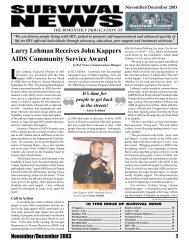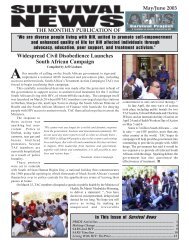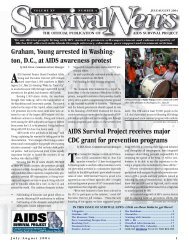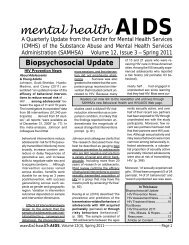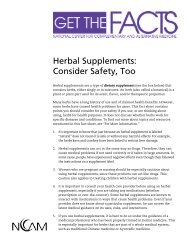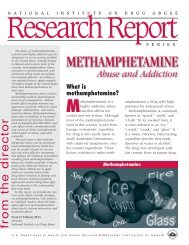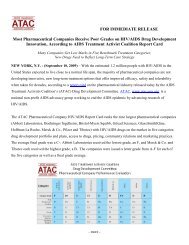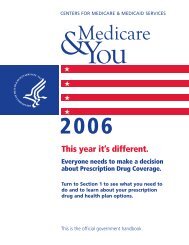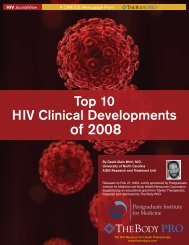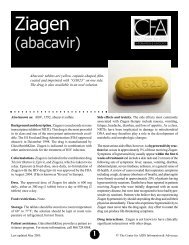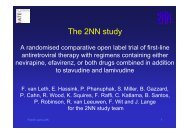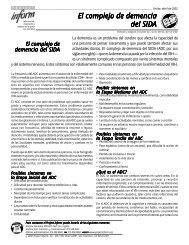here - CD8 T cells - The Body
here - CD8 T cells - The Body
here - CD8 T cells - The Body
You also want an ePaper? Increase the reach of your titles
YUMPU automatically turns print PDFs into web optimized ePapers that Google loves.
HIV care is more than just medical care. It must be coupled with<br />
services designed to uphold sexual and reproductive rights and<br />
to address the impact of violence and trauma in women’s lives.<br />
reduce new HIV infections among women,<br />
to increase access to care, or a strategy to<br />
improve women’s health outcomes. <strong>The</strong><br />
Strategy similarly failed to articulate the<br />
relationship between violence or trauma<br />
and HIV for women. And now<strong>here</strong> in the<br />
Strategy was the need to strengthen<br />
sexual health and reproductive choice for<br />
women living with HIV even mentioned.<br />
And just this year, although the<br />
President’s proposed domestic HIV budget<br />
for FY 2013 was relatively good, the Part D<br />
program was the only part of Ryan White<br />
for which a decrease was proposed. Part<br />
D is the only program within Ryan White<br />
specifically designed to meet the needs of<br />
women, youth, and families. This is indicative<br />
of an alarming trend away from women-centered<br />
care and supportive services<br />
when they are more critical than ever.<br />
Thus, not only are we faced with a<br />
well-documented social and political<br />
“war on women” from the far right, with<br />
all women’s rights and body sovereignty<br />
being utilized as a political football in the<br />
2012 election cycle—but women living with<br />
HIV are literally facing disproportionate<br />
wars: violence, and a battle for their lives,<br />
health, and dignity in their own communities,<br />
neighborhoods, and homes.<br />
And in the midst of all this, somew<strong>here</strong><br />
along the way we lost our will to address<br />
the gender nuances of the domestic HIV<br />
epidemic.<br />
2011’s HPTN 052 results demonstrated<br />
that achieving viral suppression in people<br />
living with HIV can effectively reduce<br />
onward transmission of HIV. Thus, ensuring<br />
high-quality care and access to voluntary<br />
treatment for people living with HIV should<br />
be one of our primary goals as an HIV community—to<br />
achieve the National HIV/AIDS<br />
Strategy’s prevention and care goals.<br />
In July, the International AIDS<br />
Conference (AIDS 2012) returned to the<br />
U.S. after a 22-year absence. <strong>The</strong> theme of<br />
AIDS 2012 was Turning the Tide Together—<br />
meaning that we have the science to end<br />
new HIV infections and to keep people<br />
living with HIV healthy. Now we have to<br />
muster the political will and resources to<br />
make this possibility a reality. Just last<br />
June, the Supreme Court of the United<br />
States upheld the Affordable Care Act<br />
(ACA)—a piece of legislation that holds<br />
great promise for all women, and especially<br />
for women living with HIV. But HIV<br />
care and treatment is more than just medication<br />
and more than just medical care,<br />
especially for women. It must be coupled<br />
with services designed to uphold sexual<br />
and reproductive rights and to address the<br />
impact of violence and trauma in women’s<br />
lives. Women living with HIV still face<br />
unique vulnerabilities in 2012 and turning<br />
the tide on the epidemic for women will<br />
require a gender-sensitive response.<br />
Because women’s access to health<br />
care and ability to ad<strong>here</strong> to medication<br />
is related in large part to other life factors,<br />
including our physical, psychological, and<br />
emotional safety, addressing logistical barriers<br />
to care and promoting safety for women<br />
is central to achieving the National HIV/AIDS<br />
Strategy’s goals and to achieving the promise<br />
of the Affordable Care Act for women.<br />
Through ACA implementation, we must<br />
also keep in place services that facilitate<br />
access to care for women living with HIV,<br />
including but not limited to psychosocial<br />
support, peer-based services, transportation,<br />
and childcare.<br />
Thankfully, President Obama’s March<br />
30 release of a memorandum establishing<br />
a federal interagency working group to<br />
address the intersection of HIV/AIDS, violence<br />
against women and girls, and gender-related<br />
health disparities presents a<br />
new opportunity to align the domestic HIV<br />
response with international standards and<br />
to rectify some of these serious oversights.<br />
<strong>The</strong> workgroup is charged with, among<br />
other things:<br />
n Integrating sexual and reproductive<br />
health services, gender-based violence<br />
services, and HIV/AIDS services, w<strong>here</strong><br />
research demonstrates that doing so<br />
will result in improved and sustained<br />
health outcomes.<br />
n Promoting research to better understand<br />
the intersection of the biological,<br />
behavioral, and social science bases<br />
for the relationship between increased<br />
HIV/AIDS risk, domestic violence, and<br />
gender-related health disparities.<br />
2012 marks a critical moment in the<br />
global HIV response. It’s time we truly<br />
commit to upholding women’s rights and<br />
the rights of all people living with and<br />
disproportionately impacted by HIV as an<br />
essential component to turning the tide of<br />
the epidemic. This must include:<br />
n Meaningful and visible leadership of<br />
women living with HIV in all aspects of<br />
decision-making.<br />
n Research on and funding for womencontrolled<br />
prevention options—tools<br />
which a woman can use without the<br />
consent or even the knowledge of her<br />
partner, and which uphold our full<br />
rights to sexual pleasure and sexual<br />
and reproductive health.<br />
n Bold action, including a plan and a<br />
timeline from the White House Office<br />
of National AIDS Policy to address<br />
the intersections of violence against<br />
women, HIV, sexual and reproductive<br />
rights, and women’s health.<br />
NaiNa khaNNa is the policy director at<br />
Women Organized to Respond to Lifethreatening<br />
Disease (WORLD) in Oakland,<br />
California and coordinates the U.S. Positive<br />
Women’s Network (PWN). She was<br />
appointed to President Obama’s Advisory<br />
Council on HIV/AIDS (PACHA) in 2010.<br />
She has presented and advised on women’s<br />
rights and achieving gender-sensitive,<br />
human rights-grounded policies informed<br />
by people living with HIV. Ms. Khanna was<br />
diagnosed with HIV in 2002.<br />
POSiTivElyAwARE.COM SEPTEMBER+OCTOBER 2012 25




